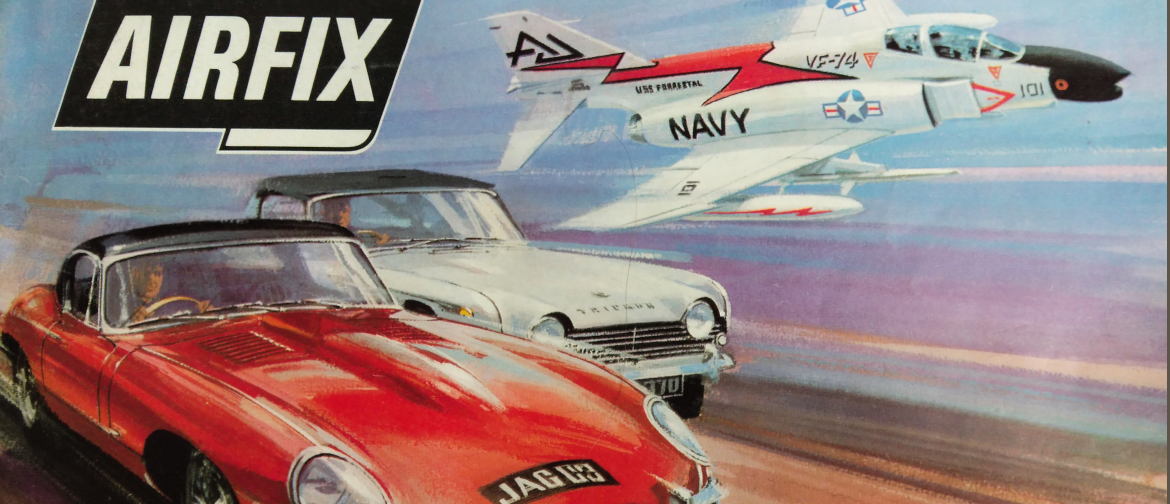A Jaguar C3 and a Triumph TR4A race a Phantom II jet of the US Navy on this cover of the 1966 Airfix catalogue, Te Manawa Museums Trust, 2020/38.
Airfix’s new style of artwork began appearing in the mid-1960s and was produced by a team of professional artists. These illustrations would eventually appear on millions of Airfix kitset boxes. While the earliest colour illustrations are attributed to Charles Oates, it is Roy Cross who became most closely associated with Airfix box-art, especially aircraft and ships. Cross had already worked as a technical artist; he started at Airfix in 1963 and remained with the company until 1974, after which he became a successful maritime artist. Cross later admitted that he wanted to join Airfix after visiting Woolworths and seeing the low-quality illustrations on the kitset header cards. Writing to Airfix claiming that he could do better, Cross was hired as a freelance artist, eventually becoming chief illustrator.[i]
In an interview, Cross explained his creative process. Instructed to illustrate a particular model, his research would include creating a maquette (initial model) that could fit within the required measurements of a specific box lid. A selection of pencil-drawn ‘box-top roughs’ would be produced and sent through for approval. Cross recalled:
They didn’t like the wing being cut off unless it could be avoided, so I had to manoeuvre my model within this space. Don’t forget I enjoyed all the facilities of the Airfix drawing office with reference to their photographs and engineering drawings. They would go up…and I would get them back ‘Yes’ or ‘No’![ii]
To complete their illustrations, artists worked in gouache. Says Cross:
It is quick to use, and you can easily apply fine detail. Normally I would know the ultimate box or header size and I would normally do the artwork ‘half-up’ (50% larger than the finished product), certainly not less.[iii]
Cross was instructed to pack lots of action into his work and would normally complete a final illustration for a small model in a week. Such is the fondness with which Cross’s illustrations are remembered, that he eventually produced two books containing his Airfix-era paintings.
Airfix Strikes Back
What was considered acceptable in marketing military models changed in the 1970s. In America, a large anti-war toy lobby emerged following the Vietnam War and especially in opposition to the popular ‘G.I. Joe’ military doll.[iv] Airfix historian Arthur Ward notes that Airfix came under pressure from Australian lobbyists to change its packaging artwork in the late 1960s, which aligns with the proliferation of the more dramatic style.[v] Airfix eventually complied and undertook an expensive process of airbrushing out falling bombs, explosions and swastikas from its illustrations. Later, an unhappy Cross observed that doing so diminished the excitement of the images, spoiling the work in the process.[vi] By the time Palitoy (the UK subsidiary of American corporation General Mills) had taken over Airfix in 1981, all original work had been excised from packaging and replaced with a photograph of the completed model sitting on a tabletop. However, the original artwork has proved enduring and today is reappearing on an Airfix range called ‘Classic Kits’.
Controversy still occasionally raises its head. In 2018, Julian Brazier, a former British MP and army officer, called on Airfix to withdraw a kitset of a bombed Afghan house, part of a range of Afghan conflict kitsets that Airfix had been marketing for some years. Brazier argued that the kitset was in bad taste because the war in Afghanistan was still raging when the kitset had gone into production. Others counter-argued that the model didn’t go far enough in conveying the destructiveness of war.[vii] The embattled Airfix (now owned by Hornby) declined to comment, but a search of online retailers reveals that the model continues to be available.
The BBC has also come in for criticism, though for different reasons. In 2009, James May’s Toy Stories series premiered on television. Episode 1 began with May, an avowed Airfix enthusiast, recreating a life-size kitset of their first aircraft model, the Supermarine Spitfire. When critics panned the series as little more than a celebrity’s vanity exercise, a BBC spokesperson weighed in:
We can justify the expense of making such a programme because it is very educational and explains clearly the historical significance of not only the history of the Airfix model, but also the important role played in the Second World War by the Supermarine Spitfire.[viii]
The Airfix catalogues in Te Manawa’s collections are important for having helped launch a market leader in the world of craft hobbies. Airfix’s self-confidence and belief in its kitset range, both to entertain as well as to educate, is manifest in the pages of these catalogues. Those seeking answers as to why modelling declined in popularity sometimes point to competition from computer-based gaming. Others believe that the Star Wars franchise had a major influence in shifting interest away from historical subjects towards sci-fi and fantasy product lines. Thanks to Covid-19 lockdowns however, one source at least notes that there has been a resurgence in interest in the hobby, if only temporarily.[ix] Like May’s ‘toy story’, the Airfix catalogue was able to convey the idea that a model that was ‘just like the real thing’ was an educational object that had the potential to arouse in modellers a curiosity for history.
Footnotes and references
[i] Malcolm Bywaters, ‘Escaping Reality: Airfix and the art of Roy Cross’, International Journal of Contemporary Humanities, vol. 5, no. 2, November 2021, p.6
[ii] Arthur Ward, AIRFIX: Celebrating 50 Years of the Greatest Plastic Kits in the World, Harper Collins, London, 1999, p.103
[iii] Ward, p.103
[iv] Ernie Smith, ‘How G.I. Joe Inspired a Movement to Ban War Toys’, Atlas Obscura, 7 November 2016, accessed 1 January 2023.
[v] Ward, p.63
[vi] Bywaters, p.5
[vii] Gerry Warren, ‘Airfix model of bombed Afghan house branded “tasteless”’, accessed 1 January 2023.
[viii] ‘In Seine’, ‘James May causes controversy over Airfix Spitfire’, The Spoof, accessed 1 January 2023.
[ix] Bywaters, p.1




